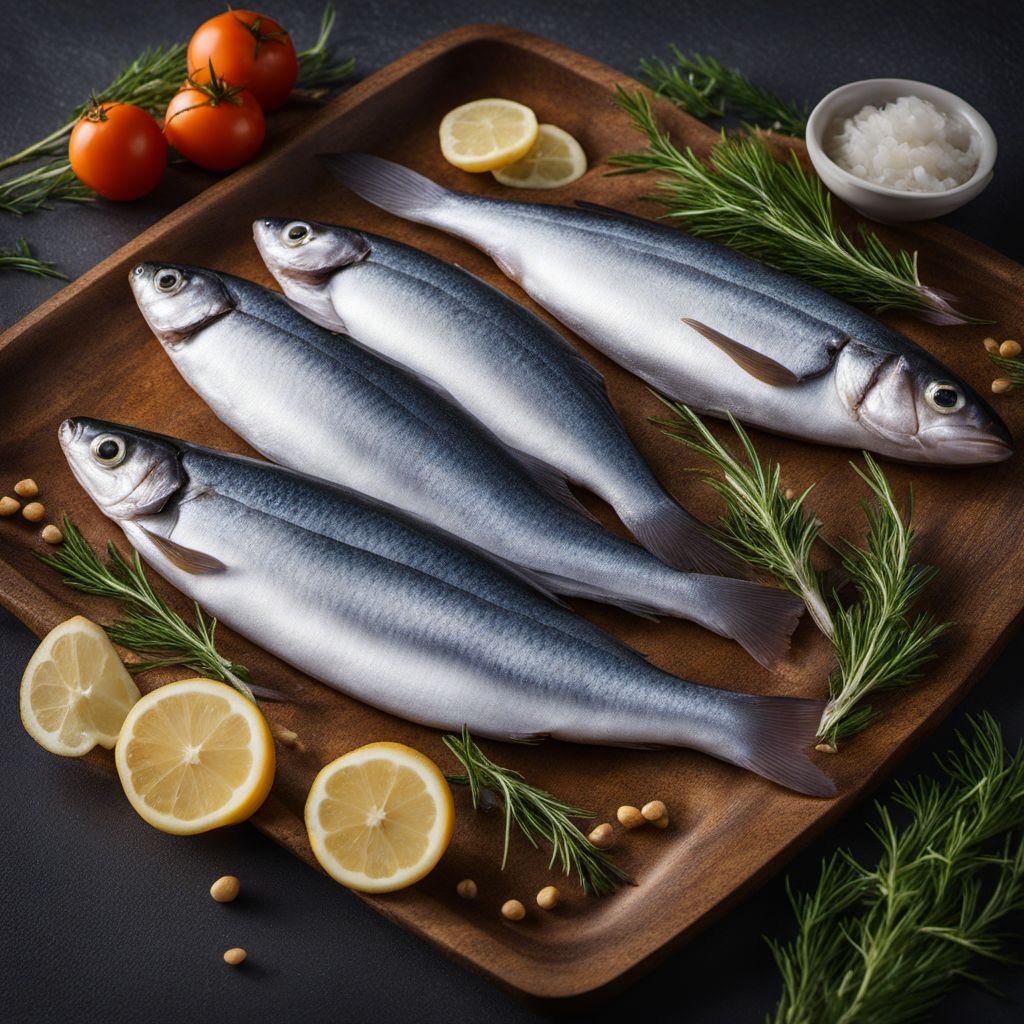
Ingredient
Herring, atlantic
The Ocean's Silver Delicacy: Atlantic Herring
Atlantic herring is a small, oily fish with a silver-blue color and a distinctive flavor. It has a firm yet tender texture and a rich, umami taste. Its versatility allows it to be prepared in numerous ways, including smoking, pickling, and grilling.
Origins and history
Atlantic herring has a long history of being a vital food source in coastal regions, particularly in Europe and North America. It has been a staple in traditional diets and has played a significant role in the fishing industry. Today, it is enjoyed in various forms, such as pickled herring, herring fillets, and smoked herring.
Nutritional information
Atlantic herring is an excellent source of omega-3 fatty acids, which are beneficial for heart health and brain function. It is also rich in protein, vitamin D, and vitamin B12. With its low calorie and fat content, it is a nutritious choice for a well-rounded diet.
Allergens
Some individuals may be allergic to fish, including herring. Allergic reactions can range from mild to severe, so it is essential to exercise caution if you have a known fish allergy.
How to select
When purchasing fresh Atlantic herring, look for fish with bright, clear eyes, shiny scales, and a fresh, mild aroma. The flesh should be firm and resilient to the touch. If buying herring fillets, ensure they are properly refrigerated and have not exceeded their expiration date. For pickled or smoked herring, check the packaging for any signs of spoilage or damage.
Storage recommendations
To maintain the freshness of fresh Atlantic herring, store it in the refrigerator at temperatures below 40°F (4°C). If purchasing pickled or smoked herring, follow the storage instructions on the packaging. Proper storage will help preserve its quality and flavor for an extended period.
How to produce
Atlantic herring is a wild-caught fish and cannot be easily produced at home. However, it is sustainably harvested in many regions, ensuring its availability for consumers.
Preparation tips
Atlantic herring can be enjoyed in various ways. It can be grilled, baked, fried, or even eaten raw in dishes like sushi or ceviche. It is commonly used in Scandinavian cuisine, where it is pickled and served with onions and sour cream. Smoked herring is a popular ingredient in traditional British kippers and Jewish cuisine.
Substitutions
Sardines, mackerel, or anchovies can be used as substitutes for Atlantic herring due to their similar oily texture and flavor. However, keep in mind that each substitute may have slight differences in taste, so adjustments may be necessary.
Culinary uses
Atlantic herring is widely used in traditional dishes and cuisines around the world. It is commonly found in pickled herring salads, herring sandwiches, fish stews, and smoked fish platters. It is particularly popular in Scandinavian, German, and Eastern European cuisines.
Availability
Atlantic herring is commonly available in coastal regions of Europe, North America, and Asia. It is heavily consumed in countries like Norway, Sweden, Germany, and the Netherlands. It can also be found in specialty seafood markets and some supermarkets.
More ingredients from this category
Recipes using Herring, atlantic

Punjabi-style Sillikaviaari
Spiced Herring Delight: Punjabi-style Sillikaviaari

Guamanian Passion Fruit Mousse
Tropical Delight: Guamanian Passion Fruit Mousse

Australasian Tropical Fruit Salad
Sun-Kissed Delight: A Taste of Australasian Tropical Fruit Salad

Namagashi with a Tropical Twist
Tropical Delights: Namagashi with a Caribbean Flair

Mató de Pedralbes - Christmas Island Style
Tropical Delight: Mató de Pedralbes with a Christmas Island Twist

Peach Gelato with a Tropical Twist
Tropical Peach Delight: A South American Gelato Experience

Gyeongdan Balls with a South American Twist
Samba Gyeongdan: A Fusion of Korean and South American Flavors

Javanese-Inspired Tropical Pavlova
Tropical Delight: Javanese-Inspired Pavlova with a Twist

South American-style Topfentorte
Tropical Delight: South American Twist on Topfentorte

Andhra-style Sild og Poteter (Herring and Potatoes)
Spicy Andhra Herring and Potato Delight

Passion Fruit Mousse
Tropical Delight: Passion Fruit Mousse
